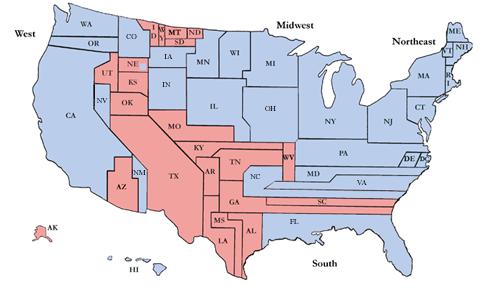Larry Sabato: That Was The Year That Was
No doubt President-elect Obama will try to inject similar hope and inspiration into his administration and the nation come January 20th. He starts from a solid base. Every four years the Center for Politics produces the"Political Map of America," which restructures the states within the continental boundaries of the United States. On the political map, each state takes up only the volume merited by its Electoral College weight. After all, trees, rocks, and acres do not vote; only people do. Giant geographic Alaska and Montana shrink to pea size while states such as California, Texas, and Florida swell considerably on this political map.

Copyright 2008 by U.Va. Center for Politics
Obama's base is broad and his Democratic Blue ranges widely. Every region of the nation is represented in his coalition, and the sectional polarization that occurred under George W. Bush has been considerably reduced. It isn't just the sweep of the territory won by Obama. Amazingly, Barack Obama's 52.7 percent of the national vote ranks sixth best among Democrats in the 38 elections since 1860. Obama ran more strongly than all but Franklin Roosevelt in his four victories from 1932 to 1944 and Lyndon Johnson's 1964 landslide. Obama ran stronger than Grover Cleveland in both his winning races (1884 and 1892), Woodrow Wilson's twin triumphs in 1912 and 1916, Harry Truman's upset in 1948, John Kennedy's paper-thin plurality in 1960, Jimmy Carter's 50.2 percent majority in 1976, and both of Bill Clinton's under-50 percent successes in the 1990s.
Partly, this is testament to the Democrats' weak White House record overall, with the party having elected only nine presidents in 148 years. Just four post-Civil War Democrats had ever won a majority of the popular vote: FDR, LBJ, Carter, and poor Samuel J. Tilden, who was denied the presidency in a disputed 1876 Electoral College allocation despite having secured 51 percent on Election Day. Obama is the fifth majority-vote Democrat.
Therefore, Obama's proportion of the vote is notable historically. Moreover, aided by widespread fear about the economic crisis as well as high marks from the public for his transition work, Obama has unusual opportunities to lengthen his honeymoon and achieve at least some of his major goals. The additional 21 Democratic seats in the House of Representatives and 7 or 8 Democratic seats in the Senate (depending on the outcome of the Minnesota recount) give Obama substantial latitude....